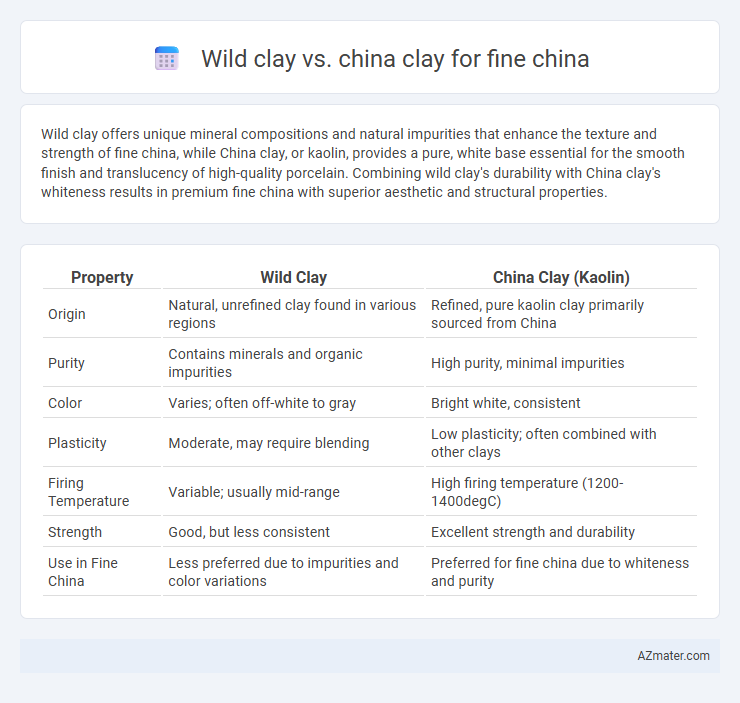Wild clay offers unique mineral compositions and natural impurities that enhance the texture and strength of fine china, while China clay, or kaolin, provides a pure, white base essential for the smooth finish and translucency of high-quality porcelain. Combining wild clay's durability with China clay's whiteness results in premium fine china with superior aesthetic and structural properties.
Table of Comparison
| Property | Wild Clay | China Clay (Kaolin) |
|---|---|---|
| Origin | Natural, unrefined clay found in various regions | Refined, pure kaolin clay primarily sourced from China |
| Purity | Contains minerals and organic impurities | High purity, minimal impurities |
| Color | Varies; often off-white to gray | Bright white, consistent |
| Plasticity | Moderate, may require blending | Low plasticity; often combined with other clays |
| Firing Temperature | Variable; usually mid-range | High firing temperature (1200-1400degC) |
| Strength | Good, but less consistent | Excellent strength and durability |
| Use in Fine China | Less preferred due to impurities and color variations | Preferred for fine china due to whiteness and purity |
Understanding Wild Clay and China Clay: Definitions
Wild clay refers to naturally occurring, untreated clay extracted directly from the earth, often containing impurities that affect its plasticity and firing characteristics. China clay, also known as kaolin, is a highly purified, white clay primarily composed of kaolinite, prized for its fine particle size, whiteness, and refractory properties essential in fine china production. Understanding these definitions highlights that wild clay lacks the refinement and consistency of china clay, making the latter the preferred material for crafting high-quality porcelain and fine china.
Geological Origins of Wild Clay vs China Clay
Wild clay originates from natural, untapped deposits often found in forested or remote areas, characterized by heterogeneous mineral content influenced by local geological conditions. China clay, also known as kaolin, forms from the chemical weathering of feldspar-rich rocks in specific geological environments, primarily granite formations, resulting in a highly pure, fine-grained mineral ideal for porcelain production. The distinct geological origins of wild clay offer variable composition and impurities, while china clay's sedimentary deposits provide consistency and whiteness crucial for fine china manufacturing.
Mineral Composition: Key Differences
Wild clay contains a diverse mix of minerals such as iron oxide, quartz, and feldspar, which contribute to its varied texture and color. China clay, also known as kaolin, is primarily composed of kaolinite, a pure white, fine-grained mineral that ensures the strength and translucency essential for fine china. These mineral composition differences impact the final product's durability, whiteness, and firing temperature, making China clay the preferred choice for high-quality porcelain.
Processing Techniques: Traditional vs Industrial
Wild clay used for fine china involves traditional processing techniques such as hand-kneading and natural drying, preserving its organic qualities and subtle mineral content. In contrast, China clay (kaolin) undergoes industrial processing, including mechanical grinding, de-dusting, and chemical refining to achieve a uniform texture and purity essential for mass production. These differences influence the final product's translucency, strength, and aesthetic appeal, with wild clay offering unique, artisanal characteristics and China clay providing consistency and durability in fine china manufacturing.
Purity Levels: Impact on Fine China Quality
Wild clay contains higher mineral impurities compared to refined China clay, which affects the translucency and strength of fine china products. China clay, also known as kaolin, is prized for its exceptional purity, contributing to the fine china's smooth texture and resistance to chipping. The elevated purity levels in China clay result in a more durable, elegant finish, crucial for high-quality fine china manufacturing.
Color and Texture Variations in Fine China Production
Wild clay exhibits natural impurities and mineral variations, resulting in a coarser texture and uneven color in fine china production. China clay, also known as kaolin, provides a purer white color and smoother texture, essential for the delicate and refined appearance of fine china. These differences significantly influence the final product's translucency, strength, and aesthetic appeal in manufacturing processes.
Workability and Plasticity: Potters’ Perspectives
Wild clay exhibits higher workability and plasticity compared to China clay, making it favored by potters seeking greater versatility in shaping and forming fine china pieces. China clay, primarily composed of kaolinite, offers a smooth, fine texture but can be less pliable during the molding process, requiring precise moisture control. Potters value wild clay for its responsiveness to wheel-throwing and hand-building techniques, enhancing detail and reducing the risk of cracking.
Fired Strength and Durability: Wild Clay vs China Clay
Wild clay and China clay differ significantly in fired strength and durability when used for fine china production. China clay, also known as kaolin, provides superior fired strength due to its high purity and fine particle size, resulting in enhanced durability and resistance to chipping. Wild clay often contains impurities and coarser particles, leading to lower fired strength and increased susceptibility to cracks and wear in fine china applications.
Sustainability and Environmental Considerations
Wild clay, sourced naturally with minimal processing, offers a more sustainable option for fine china due to its lower energy consumption and reduced chemical use compared to refined China clay, which often requires intensive mining and extensive purification. Wild clay's extraction tends to have a smaller environmental footprint, preserving soil integrity and local ecosystems, whereas China clay mining can cause significant land degradation and water pollution. Choosing wild clay supports eco-friendly production practices and aligns with growing consumer demand for environmentally responsible fine china.
Choosing the Best Clay for Fine China Manufacturing
Wild clay contains natural impurities and inconsistent mineral content, leading to variable firing results and reduced translucency in fine china. China clay, also known as kaolin, offers high purity, excellent plasticity, and superior whiteness, ensuring durability and the delicate finish required for fine china manufacturing. Selecting kaolin enhances the strength, translucency, and smooth texture essential for premium fine china production.

Infographic: Wild clay vs China clay for Fine china
 azmater.com
azmater.com